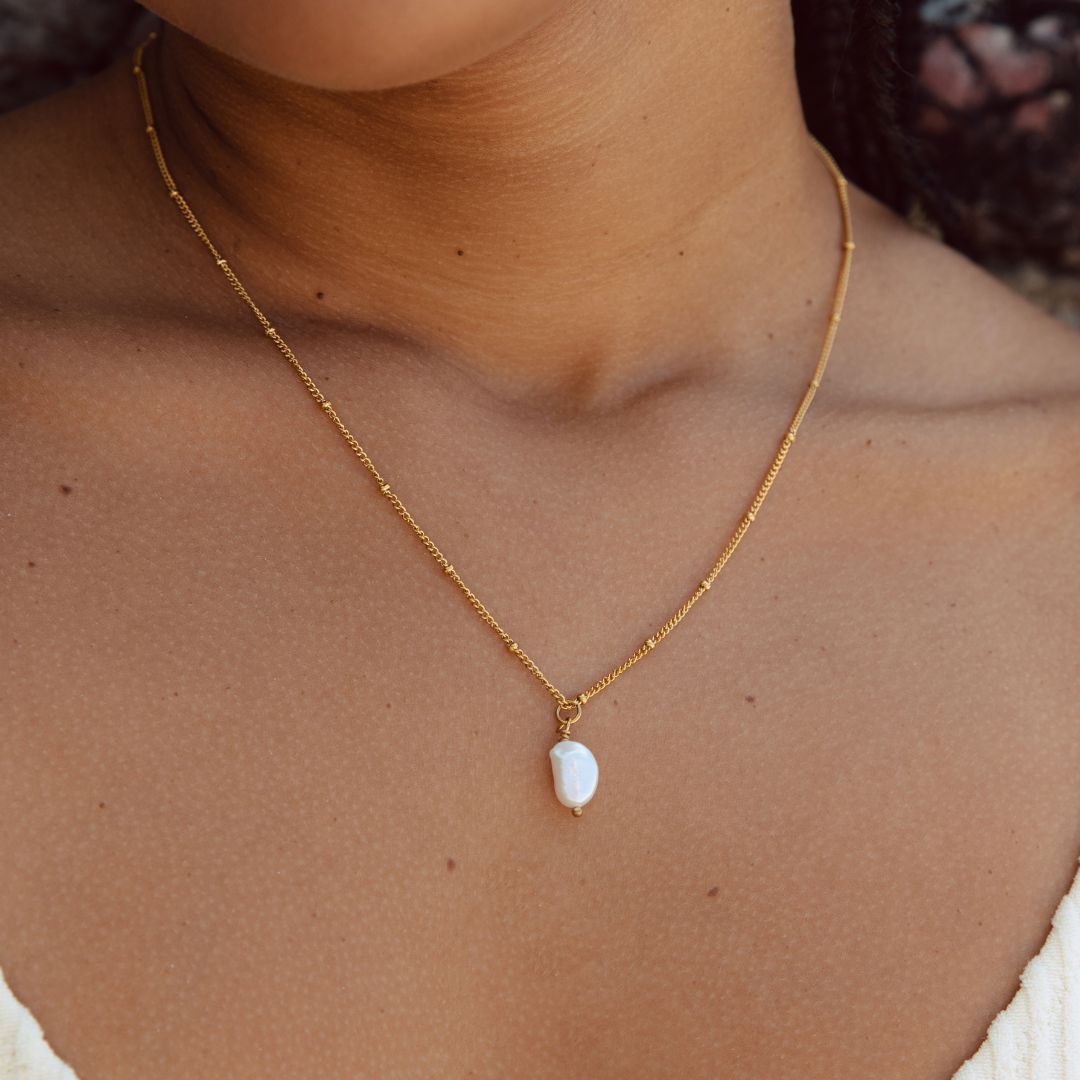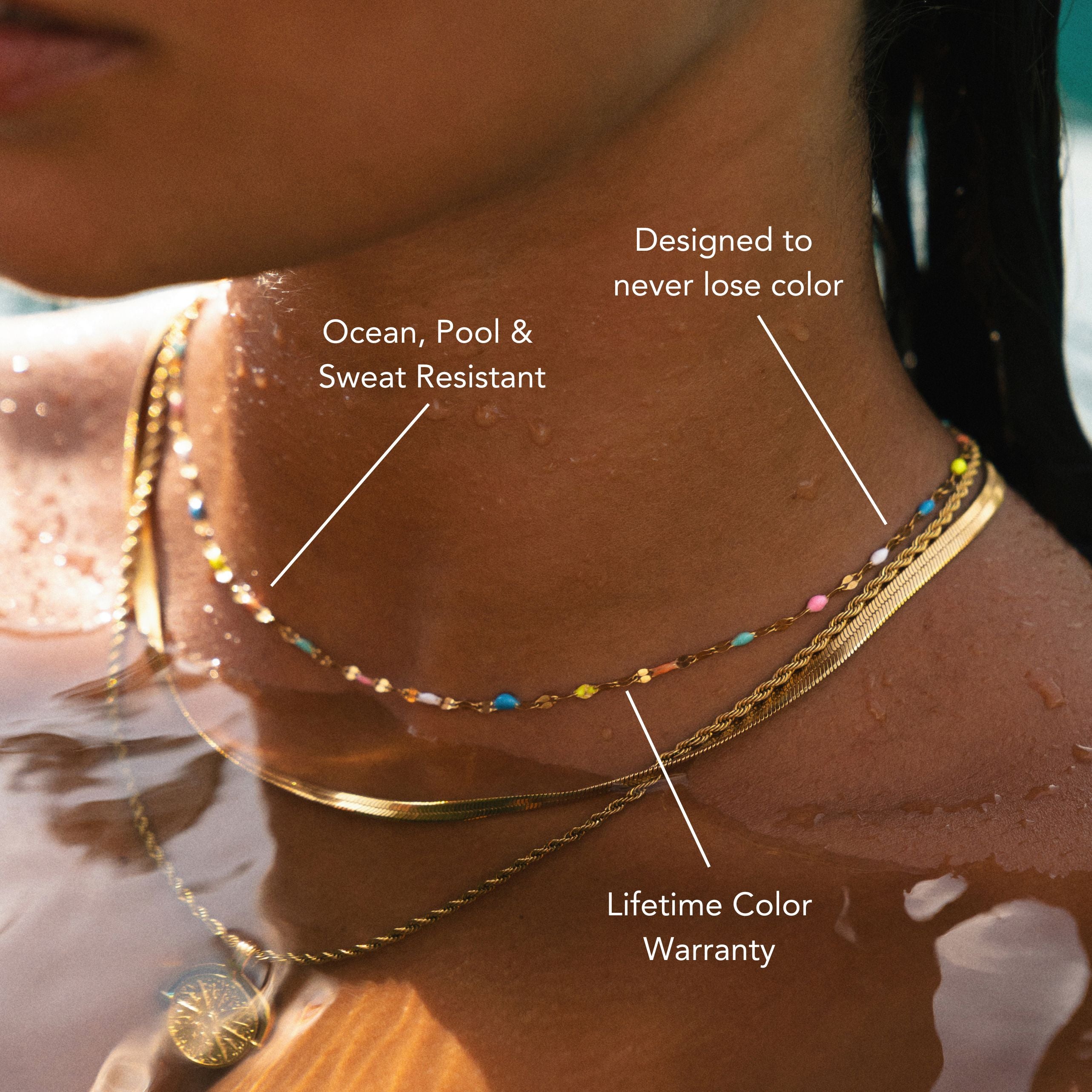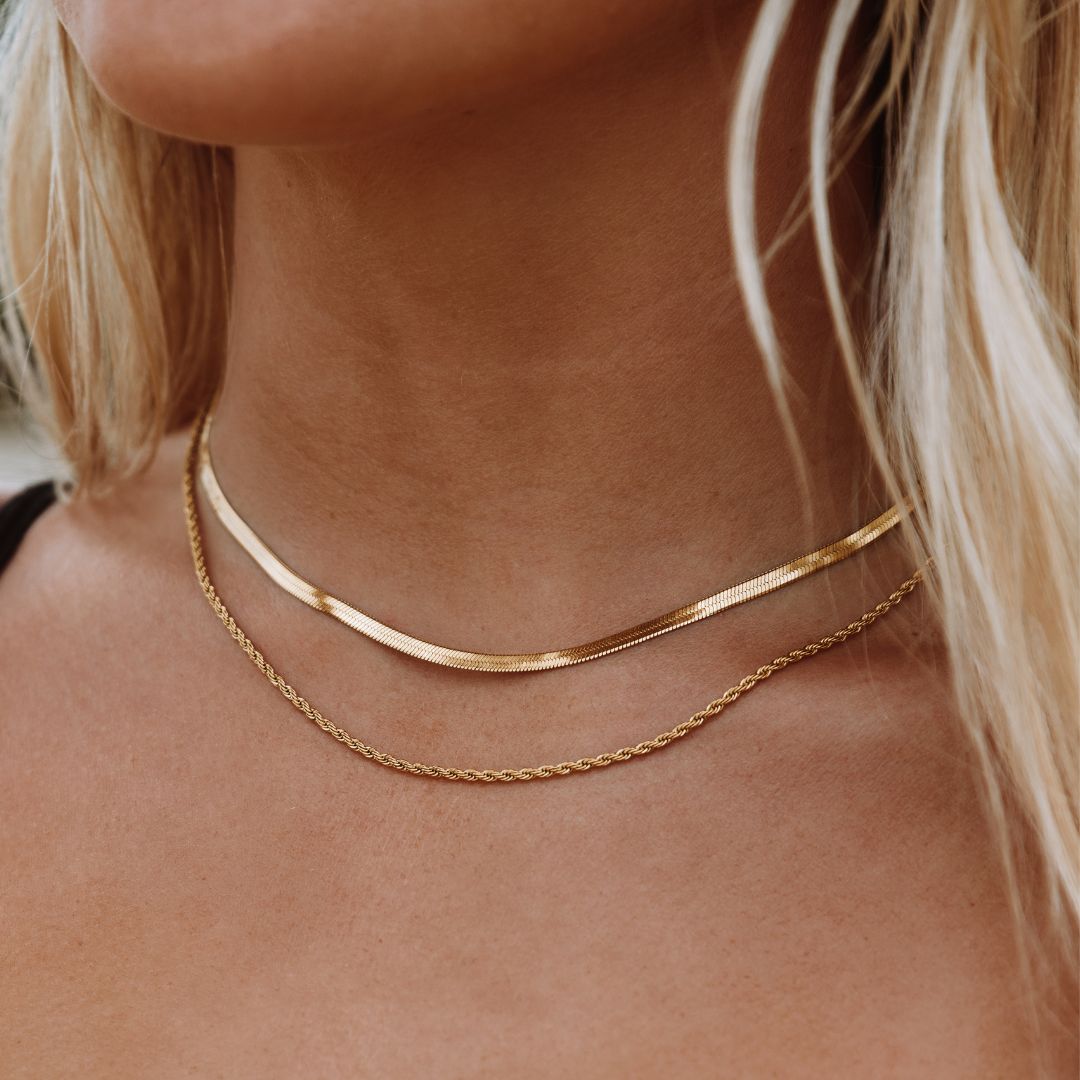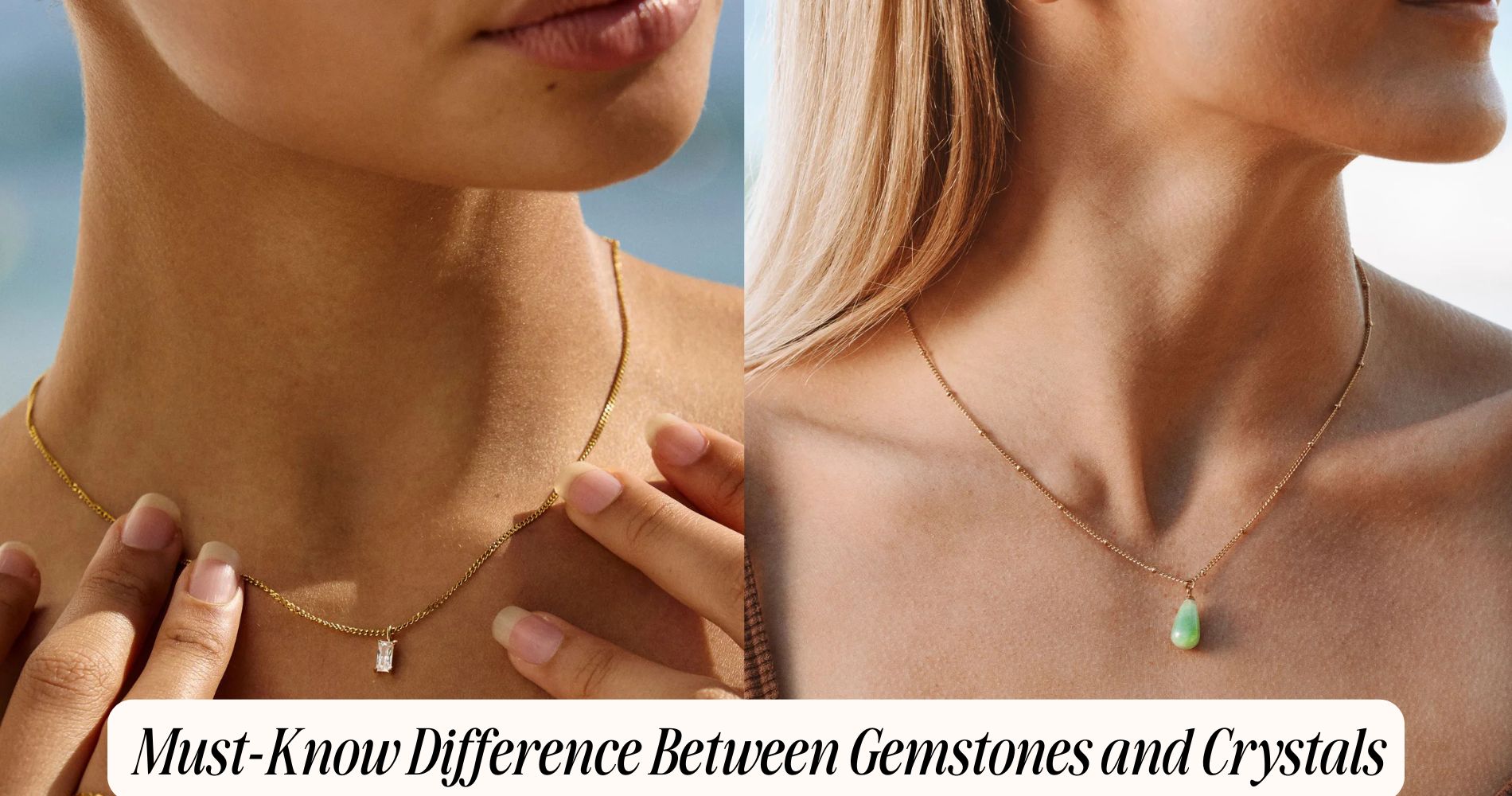
What Are The Different Types Of Opals?
There are many fascinating types of opals, each with its own unique traits and allure. White Opals captivate with a milky appearance and vibrant play-of-color, while Black Opals stand out for their deep body tone and bright, colorful flashes. Boulder Opals showcase vivid patterns within ironstone, and Crystal Opals display a mesmerizing transparency with colorful reflections. Fire Opals bring warmth with their shades of orange and red, and both Opal Triplets and Doublets combine layers to boost durability and beauty. Ethiopian Opals, formed from volcanic activity, offer distinct visuals, and Peruvian Opals charm with their pastel tones. Explore our Waterproof Jewelry Collection to find pieces that perfectly highlight these enchanting gemstones. Stay tuned to discover more about their origins and uses.
White Opal
White opal is one of the most popular varieties of opal, recognized for its milky appearance and vibrant play-of-color. Its history dates back to ancient civilizations, where it was revered for its supposed protective qualities. In the past, white opal was often associated with purity and innocence, making it a favored gemstone among royalty and the elite.
As you explore white opal's symbolism, you'll find it represents hope, creativity, and emotional balance. Many believe that wearing white opal can enhance your imagination and amplify your thoughts, acting as a conduit for inspiration. This gemstone is also thought to promote spiritual growth and self-awareness, making it a potent tool for personal development.
In terms of composition, white opal primarily contains silica and water, giving it a unique structure that contributes to its play-of-color. You'll notice that the intensity of color varies, influenced by factors such as the size and arrangement of silica spheres within the stone.
Whether you're considering white opal for jewelry or as a collector's item, understanding its history and symbolism can enhance your appreciation for this enchanting gem.
Black Opal
Known for its striking dark body tone, black opal is one of the most sought-after varieties of opal, prized for its vibrant play-of-color that stands out against its deep background. The play-of-color, a result of the opal's unique silica structure, can display an array of colors, making each stone a unique masterpiece.
Mining techniques for black opal vary by location, with Australia being the primary source. Miners often use both traditional and modern methods, including shaft mining and open-pit mining, to extract these precious stones from the earth.
The process requires skill and knowledge to identify high-quality opals among the surrounding rock.
It's important to be aware of synthetic opals, which are created in laboratories and can mimic the appearance of natural black opals. While these synthetic varieties can be visually appealing and often more affordable, they lack the rarity and value of genuine black opals.
When purchasing, always verify the stone's authenticity through reputable sources to guarantee you're investing in a true natural wonder.
Boulder Opal
Boulder opal forms in ironstone matrices, resulting in a unique visual appeal that distinguishes it from other opals.
You'll notice its vivid color patterns and the way it contrasts with the host rock, creating striking designs.
Proper care is essential to maintain its beauty and durability, so understanding maintenance tips is vital.
Formation and Origin
Opals form through a complex interplay of silica-rich water and geological processes, with boulder opals originating specifically in the unique environment of ironstone.
These opals are found embedded within ironstone boulders, which provide a natural host for the formation of opal deposits. The geological processes involved include the gradual weathering of silicate minerals, allowing silica to dissolve in water.
Over time, as the water seeps through rock layers, it carries dissolved silica, which eventually precipitates to form opal. The formation process is influenced by factors such as temperature, pressure, and the presence of other minerals.
In ironstone, the silica-rich solutions can fill voids and cavities, leading to the creation of boulder opals. As the host rock undergoes erosion, these opals become exposed, showcasing their unique characteristics.
In Australia, particularly in Queensland, extensive boulder opal deposits were formed during periods of volcanic activity, contributing to the concentration of these gems.
Understanding the formation and origin of boulder opals provides insight into their unique properties and the geological history of the regions where they're found.
Unique Visual Characteristics
The unique visual characteristics of boulder opals stem from their formation within ironstone, which influences their appearance in remarkable ways. When you observe boulder opals, you'll notice the striking contrast between the vibrant play-of-color and the dark, earthy tones of the ironstone matrix. This combination enhances the visual appeal, making each stone an enchanting piece of nature's artistry.
One of the key optical phenomena associated with boulder opals is the opalescence, which creates a mesmerizing shift in color as you change your viewing angle. This effect is due to the microscopic silica spheres within the opal, which diffract light and produce a spectrum of colors. The presence of the ironstone matrix further accentuates these colors, often resulting in a background that ranges from deep browns to rich reds.
Additionally, the uneven surface texture of boulder opals can create unique reflections and light patterns, adding to their overall allure. Each boulder opal is distinct, showcasing a harmonious blend of natural elements that contribute to its one-of-a-kind visual impact.
When you look at a boulder opal, you're not just seeing a gemstone; you're experiencing a natural masterpiece.
Care and Maintenance Tips
Proper care and maintenance of boulder opals is essential to preserve their beauty and integrity. Start with effective cleaning methods; use lukewarm, soapy water and a soft cloth. Avoid harsh chemicals or ultrasonic cleaners, as they can damage the opal's surface.
For storage solutions, keep your boulder opals in a soft pouch or lined box to prevent scratches. Guarantee humidity control in your storage area, as excessive moisture can lead to deterioration.
Be mindful of temperature sensitivity; sudden temperature changes can cause cracking. When wearing jewelry, practice handling tips by removing your boulder opal pieces before engaging in activities that may expose them to harsh conditions, like swimming or exercising.
For ongoing jewelry maintenance, inspect your boulder opals regularly for signs of wear or damage. If you notice any issues, seek professional care to guarantee proper treatment.
Crystal Opal
Crystal opal is renowned for its stunning transparency and vibrant play-of-color, making it a favorite among gem enthusiasts. When you examine this type of opal, you'll notice its exceptional crystal clarity, which allows light to penetrate deep within the stone, enhancing its colorful displays.
The interplay of light and color in crystal opal creates a mesmerizing effect that can change with the angle of view. Typically, crystal opals showcase a range of crystal hues, from blues and greens to reds and oranges. These colors are often vivid and can appear almost luminescent against the transparent background.
Because of their unique optical properties, crystal opals require proper lighting to truly appreciate their beauty. When considering purchasing crystal opal, it's crucial to evaluate its clarity and color intensity. A higher degree of transparency usually correlates with greater value.
Additionally, these opals are often cut into various shapes to accentuate their play-of-color, making them ideal for jewelry. To sum up, crystal opals stand out for their elegance and brilliance, appealing to those who appreciate fine gemstones and their striking visual effects.
Fire Opal
While crystal opal captivates with its transparency and vibrant colors, fire opal offers a different allure with its warm, fiery hues. Originating primarily from Mexico, fire opal is characterized by its striking orange, red, and yellow tones, which can sometimes exhibit a play of color, though this is less common than in other opal types. The presence of iron oxide in the structure contributes to its distinctive warm palette.
Fire opals are often associated with powerful symbolism. They represent passion, creativity, and personal power, making them a popular choice for those seeking inspiration or a boost in confidence. Many wearers believe that fire opals can enhance emotional stability and bring about positive transformations in their lives.
When selecting a fire opal, consider its clarity, color saturation, and the presence of any internal features. Quality specimens can be quite valuable, particularly those with vivid colors and translucency.
Understanding fire opal origins and symbolism enhances your appreciation for this unique gemstone, allowing you to make informed choices whether for personal use or as a meaningful gift.
Opal Doublet
Created by layering a thin slice of natural opal over a backing material, opal doublets offer a striking combination of beauty and affordability. This construction enhances the visual appeal while maintaining a lower cost compared to solid opals.
The advantages of opal doublets include their ability to showcase vibrant play-of-color, which is often amplified by the reflective backing. This makes them particularly attractive in various jewelry settings.
You'll find opal doublets commonly used in rings, pendants, and earrings, where their stunning appearance can be highlighted. The use of a backing material not only enhances color depth but also provides durability, making these pieces suitable for everyday wear.
Additionally, their lighter weight compared to solid opals can be more comfortable for larger designs.
When considering opal doublet applications, you should note their versatility. They can be set in various metals, including gold and silver, and can be incorporated into both modern and traditional designs.
Opal Triplet
How do opal triplets enhance the beauty of opal jewelry? Opal triplets consist of three layers: a top layer of clear quartz or glass, a middle layer of opal, and a backing layer, typically made of black material. This construction not only amplifies the opal's vibrant colors but also protects it from scratches and damage.
One of the key opal triplet benefits is durability; they're more resilient than solid opals, making them ideal for everyday wear.
In terms of opal triplet applications, these stones are popular in various types of jewelry, including rings, pendants, and earrings. The protective top layer helps maintain the opal's luster and brilliance while ensuring the intricate patterns remain visible.
When you wear opal triplet jewelry, you can enjoy the enchanting effects of opal without the same level of care needed for solid stones.
Moreover, the affordability of opal triplets makes them accessible to a wider audience, allowing you to experience the beauty of opal without a significant investment.
Ethiopian Opal
Ethiopian opals form from volcanic activity, resulting in a unique structure that influences their characteristics.
You'll notice a striking array of color play variations, often displaying vibrant hues due to the presence of silica spheres.
Understanding these features can enhance your appreciation for this enchanting gem.
Formation and Characteristics
Opal's enchanting beauty stems from its unique formation process, particularly in the case of Ethiopian opal. This type of opal forms in volcanic rock, primarily in the region of Wollo, where silica-rich solutions seep into cavities and fractures. Over time, the silica solidifies, creating the vibrant and often translucent gemstones you see today.
Unlike other opal types, Ethiopian opals usually develop a more stable structure due to their formation in a less hydrated environment, which contributes to their durability.
You might find it interesting that Ethiopian opals are often associated with various opal myths, including beliefs about their healing properties. However, it's crucial to rely on scientific understanding rather than folklore when considering the characteristics of these gemstones.
Ethiopian opals can exhibit a wide range of features, such as their unique play-of-color and the presence of natural patterns. These characteristics set them apart from other opal varieties, making them highly sought after by collectors and enthusiasts alike.
Understanding the formation process and inherent traits of Ethiopian opals enhances your appreciation of their distinct beauty and geological significance.
Color Play Variations
The mesmerizing play of color in Ethiopian opals is one of their most enchanting features, showcasing a spectrum that can range from vivid reds and greens to soft blues and yellows. This opal variety exhibits exceptional color play due to its unique structure, which enhances light interaction and produces stunning visual effects.
The interplay of light creates iridescent hues that shift as you move the gemstone, adding to its allure. Ethiopian opals come in various gemstone varieties, each displaying distinct color intensity and brilliance levels. Some stones show a broad opal spectrum, while others may feature specific dominant colors, making them highly sought after.
The rarity of certain color combinations further contributes to the opal's value, as collectors prize those with rich optical phenomena. Understanding the factors that influence color play in Ethiopian opals allows you to appreciate their beauty fully.
The intricate design of silica spheres within the stone refracts light, resulting in enchanting patterns that can mesmerize anyone who gazes upon them. Exploring these variations not only enhances your knowledge but also enriches your experience when selecting or admiring these stunning gemstones.
Peruvian Opal
Hailing from the Andes mountains, Peruvian opal is renowned for its striking colors and unique play-of-color. With its Peruvian origins, this opal is prized not only for its aesthetic appeal but also for its cultural significance among local communities.
You'll find that the stone often showcases a range of color variations, including pastel hues of blue, green, and pink, which can create breathtaking unique patterns.
The mining techniques used to extract Peruvian opal differ from those employed in other regions, often relying on artisanal methods that preserve the environment while ensuring high-quality yields. This commitment to sustainable mining practices can influence the market value of Peruvian opals, making them sought-after in both jewelry and collector circles.
Additionally, many believe in the healing properties of Peruvian opal, attributing benefits such as emotional balance and spiritual growth to its energy.
When comparing Peruvian opal to other types, factors such as color intensity, clarity, and pattern uniqueness play significant roles in determining their value.
Water Opal
Water opal, often referred to as "hyalite," is a fascinating variety of opal known for its remarkable transparency and vivid internal play-of-color. This unique gemstone primarily originates from volcanic deposits, where silica-rich water interacts with minerals, resulting in the formation of this striking opal variety.
You'll notice that water opal exhibits a glass-like appearance, which enhances its ability to refract light, creating a mesmerizing display of colors. This transparency sets it apart from more opaque opals, making it particularly sought after in jewelry and decorative pieces.
In terms of water opal healing properties, many believe that this stone promotes emotional balance and clarity of thought. You might find that it supports self-awareness and helps in overcoming negativity, making it a popular choice among crystal healers.
When you wear or carry water opal, you can tap into its soothing energies, which are thought to enhance communication and expression.
Whether you're drawn to its aesthetic beauty or its purported healing benefits, water opal certainly holds a special place within the diverse world of opals.
Frequently Asked Questions
What Makes Opal Prices Vary Significantly Among Different Types?
Opal prices vary markedly due to factors like opal color play, which influences visual appeal, and opal origins, where rarer sources typically command higher prices. You'll find these elements essential when evaluating opal value.
How Do I Properly Care for My Opal Jewelry?
To care for your opal jewelry, use gentle opal cleaning techniques like a soft cloth and lukewarm water. Store them in a padded box or bag to prevent scratches and damage from exposure to light.
Can Opals Be Worn Every Day?
You can wear opals daily, but their durability varies. Avoid harsh conditions and chemicals to prevent damage. Regular care will help maintain their beauty, ensuring your opal jewelry remains vibrant even with frequent wear.
Are Opals Suitable for All Skin Types?
Opals can be suitable for all skin types, provided you consider opal color and opal clarity. Generally, clearer opals with vibrant colors tend to complement various skin tones, enhancing your overall appearance and style.
What Should I Look for When Purchasing Opals?
When purchasing opals, consider opal grading and any opal treatments. Check for color play, clarity, and stability. Understanding these factors guarantees you choose a high-quality gem that meets your expectations and investment goals.
Conclusion
To conclude, opals come in various types, each with distinct characteristics and appeal. Whether you're drawn to the brilliance of white opal, the depth of black opal, or the unique patterns of boulder opal, there's an opal to suit every taste. Crystal opals and fire opals offer vibrant colors, while opal triplets and Ethiopian opals showcase innovative craftsmanship. Exploring these varieties can enhance your appreciation for this enchanting gemstone and its diverse beauty.






















Leave a comment
This site is protected by hCaptcha and the hCaptcha Privacy Policy and Terms of Service apply.